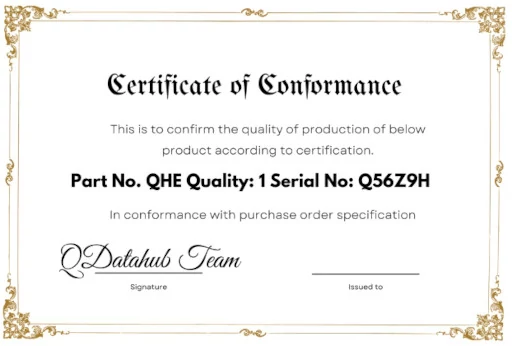CoC meaning and its perception varies a lot among different industries and their practical use cases.
In short, CoC is a letter of warranty or a list of specifications for the buyer.
Seller issues a CoC to warrant or to show certain specifications.
- The seller issues a CoC to promote and support the quality of his product.
- The seller makes one CoC for each product and issues it to the buyer.
- The buyer asks for a CoC to safeguard his investment.
- The buyer asks for certain information on the CoC, that otherwise needs a destructive test to verify.
- The buyer asks for certain information on the CoC, that cannot verify.

CoC name variation
The concept of CoC is used among different industries and has many names. Some of such CoC have found their own unique name because of popularity and common use. some good examples are as follows
WETT certificate: Which in fact is a CoC for wood-burning appliances inspection.
Certificate of Location: This is a CoC for a real state and is commonly used in some jurisdictions.
Property Survey: This is a CoC for a real state, the same as a Certificate of Location. This name is more common in some jurisdictions.
Binder: This is the name that the insurance company uses when issuing their temporary and short CoC.
Chain of CoC
The buyer keeps the letter of Conformance for future reference or claims. A CoC may come with a chain of CoC from others. For example, the fireplace CoC consists of three independent but interrelated documents. One Certificate of Conformance comes from the manufacturer conforming to the fireplace specifications. One CoC comes from the installer conforming to the installation according to the regulation. And finally, one CoC comes from the chimney inspector confirming the operation. Buyers may use the chain of CoC to support the quality of their product to another level. In this example, the insurance company asks for CoC before providing insurance. The insurance company trusts the chain of CoC as conformance of the fireplace as a qualified appliance for the house.
Third-Party CoC
Some CoC carries a higher risk, value, or importance and cannot be issued by the seller directly. The process of verification and conformity did by an independent third party. And respectively they issue the CoC on behalf of the seller. A good example is the Certificate of Location for a real estate transaction. The seller cannot issue the certificate to the buyer. A land surveyor performs the verification and provides a certificate to the buyer. In this example, CoC is called differently, yet the purpose is the same. The buyer is trying to get the specification of the house, the location, and the size. The seller is confirming what is sold matches the specification and the buyer is getting the specification on a certified letter.
Certification Body
The third-party CoC should be differentiated from the process of Conformity assessment and certification. Most regulatory agencies set the rule, but are not directly issuing the certification. Hence they leave the job of certification to an independent third party. For example, ISO uses the term certification body to explain this process.
Implicit CoC
Likewise, some CoC is not exchanged and taken at face value or implicitly by their literal word. A good example is Winter Tire. You buy winter tires. The insurance company provides discounts for having winter tires. And police (in certain states and provinces) accept the winter tire on the car by seeing it. No one asks for the CoC of the manufacturer for the winter tire. Yet such a certificate of compliance is implicitly assumed from the manufacturer, that what is said to be a winter tire is in fact winter tire and in compliance with winter tire requirements.
CoC course of action
If a product or service is malfunctioning, the buyer has a course of action. The buyer can use the Certificate to contact the seller and ask for a fix. Of course, each CoC comes with terms and conditions. For example, if the remote control stops working, the buyer can ask for the fix, but not for replacement batteries.
Inevitably, in the case of implicit CoC, if such implicit and public trust proofs are wrong or manipulated, the consequences will be harsh. A manufacturer who repackages and labels the same all-season tire as a winter tire is subject to hefty fines. In such a scenario, the credibility of the organization that has issued the certificate of conformity to the manufacturer will be undermined as well. That is why such authorities have a scheduled process of review of conformity in place. For example, ISO requires a yearly assessment of conformity for certain standards.
